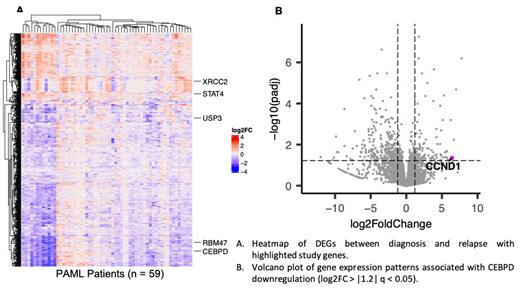Despite improvements in the treatment options, acute myeloid leukemia (AML) remains a fatal malignancy with an estimated 5-year relative survival rate of 31.7%. There is continued need for identification of new disease drivers to develop novel therapeutic options and improve clinical outcomes. Dysregulated transcriptional landscapes are associated with disease pathogenesis and treatment responses. To identify new disease drivers of AML, we analyzed RNA-Seq data from 59 patient-matched diagnosis and relapse (PAML) specimens (study cohort). A set of five differentially expressed genes (DEGs; STAT4, XRCC2, USP3, CEBPD, RBM47) with concordant changes in expression between diagnosis and relapse (Figure 1A) were selected for study using the following criteria: (a) concordant differential expression (DESeq2: log2FC > |1.2| and q < 0.05) in at least 25% of the relapsed patients in the study cohort (b) concordant differential expression in independent datasets of RNA-Seq without any experimental validation, and (c) high cancer driver potential based on their molecular function. Binding analysis for regulation of transcription (BART) on DEGs between normal CD34 + cells, diagnosis and relapsed AML patient specimens suggested that CEBPD could function as a transcriptional regulator of a subset of the DEGs. We hypothesized that dysregulated expression of these genes promotes AML disease progression.
To examine their role in AML, we altered their expression in AML cell line models and measured changes in AML cell phenotypes. Of these genes, CRISPR-mediated knockdown of the transcription factor CCAAT/enhancer-binding protein delta (CEBPD) enhanced AML cell proliferation, self-renewal capacity, and survival of the relapsed AML cell line OCI-AML5. CEBPD knockdown also conferred OCI-AML5 resistance to cytarabine - a common chemotherapy drug used for AML treatment. Short hairpin RNA (shRNA)-mediated knockdown of CEBPD in OCI-AML5 validated these results. CRISPR-mediated upregulation of CEBPD expression induced monocyte/macrophage differentiation marker CD14 expression and enhanced apoptosis rates in OCI-AML5 cells. CEBPD upregulation also induced differentiation in the diagnosis AML cell line OCI-AML2. Survival analyses showed that lower expression of CEBPD was significantly associated with poor survival in pediatric AML patients, and there was a trend of lower CEBPD expression associating with worse survival in adult AML patients (UCSC Xena browser). These results altogether suggest that CEBPD plays a tumor suppressor role in AML. Gene set enrichment analyses (GSEA) on RNA-Seq data revealed significant positive enrichment of cell proliferation pathways upon CEBPD knockdown in OCI-AML5 cells as well as in a subset of the PAML patients with downregulated CEBPD expression at relapse. Differential gene expression and GSEA analyses altogether suggested upregulated cyclin D1 as one of the downstream drivers of enhanced growth of AML cells with repressed CEBPD expression (Figure 1B). RT-qPCR and Western Blot experiments confirmed upregulation of CCND1 expression in CEBPD knockdown OCI-AML5 and OCI-AML2 cells. Next, we sought to understand the molecular mechanisms repressing CEBPD expression during AML disease progression. We found an inverse association between CEBPD and DNMT3 methyltransferases mRNA expression in PAML and independent datasets. Treatment with the hypomethylating agent azacitidine upregulated CEBPD mRNA expression in multiple AML cell lines including OCI-AML5 and OCI-AML2, suggesting that hypermethylation represses CEBPD gene expression in these AML cells. Integrative analysis of gene expression with DNA methylation at the CEBPD promoter identified hypermethylation of multiple CpGs within the binding region of the transcription factor Sp1 in a subset of patients with CEBPD downregulation. CpG methylation has been shown to interfere with Sp1 binding at the CEBPD promoter. Since Sp1 binding promotes CEBPD transcription, hypermethylation at these sites may repress CEBPD expression during AML disease progression.
Our study suggests that CEBPD can function as tumor suppressor in AML. Results suggest a role for DNA methylation in repressing CEBPD expression during AML disease progression. Furthermore, we show that CEBPD repression promotes AML cells' growth potentially via inducing the expression of the cell cycle driver CCND1.
Disclosures
Dillon:Pfizer: Consultancy, Honoraria, Membership on an entity's Board of Directors or advisory committees, Research Funding; Novartis: Consultancy, Honoraria, Speakers Bureau; Jazz: Consultancy, Honoraria, Membership on an entity's Board of Directors or advisory committees, Research Funding, Speakers Bureau; AvenCell: Consultancy, Honoraria, Membership on an entity's Board of Directors or advisory committees; Astellas: Consultancy, Honoraria, Speakers Bureau; Amgen: Research Funding; Shattuck labs: Consultancy, Honoraria, Membership on an entity's Board of Directors or advisory committees; Abbvie: Consultancy, Honoraria, Membership on an entity's Board of Directors or advisory committees, Research Funding, Speakers Bureau. Bullinger:Gilead: Honoraria, Membership on an entity's Board of Directors or advisory committees; Abbvie: Honoraria, Membership on an entity's Board of Directors or advisory committees; Jazz Pharmaceuticals: Honoraria, Membership on an entity's Board of Directors or advisory committees, Research Funding; Bayer Oncology: Research Funding; Pfizer: Honoraria, Membership on an entity's Board of Directors or advisory committees; Janssen: Honoraria, Membership on an entity's Board of Directors or advisory committees; Amgen: Honoraria; Bristol-Myers Squibb: Honoraria; Daiichi Sankyo: Honoraria; Sanofi: Honoraria; Astellas: Honoraria; Celgene/BMS: Honoraria, Membership on an entity's Board of Directors or advisory committees; Novartis: Honoraria, Membership on an entity's Board of Directors or advisory committees. Carroll:Cartography Bioscences: Membership on an entity's Board of Directors or advisory committees; Janssen Pharmaceuticals: Consultancy. Levine:Isoplexis: Membership on an entity's Board of Directors or advisory committees; Incyte: Consultancy; C4 Therapeutics: Membership on an entity's Board of Directors or advisory committees; Prelude: Membership on an entity's Board of Directors or advisory committees; Auron: Membership on an entity's Board of Directors or advisory committees; AstraZeneca: Consultancy, Honoraria; Zentalis: Membership on an entity's Board of Directors or advisory committees, Research Funding; Mission Bio: Membership on an entity's Board of Directors or advisory committees; Ajax: Membership on an entity's Board of Directors or advisory committees, Research Funding; Qiagen: Membership on an entity's Board of Directors or advisory committees; Janssen: Consultancy; Novartis: Consultancy; Roche: Honoraria; Amgen: Honoraria; Lilly: Honoraria. Melnick:Janssen: Research Funding; Daiichi Sankyo: Consultancy, Research Funding; Treeline Biosciences: Consultancy; Ipsen: Consultancy, Research Funding.


This feature is available to Subscribers Only
Sign In or Create an Account Close Modal